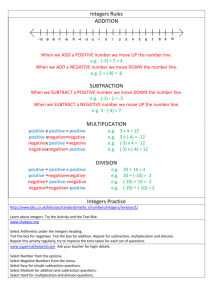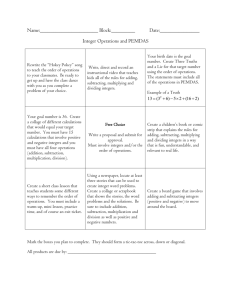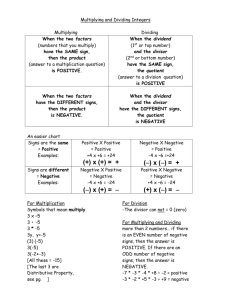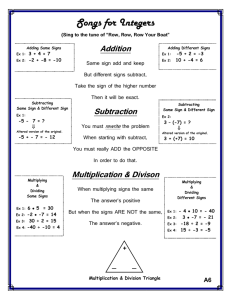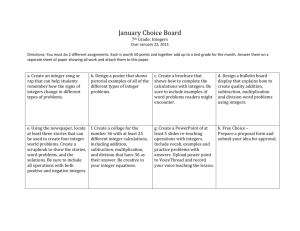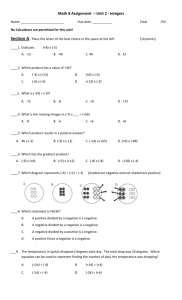NSM105 – Fundamentals of Math Unit 5 Notes
advertisement
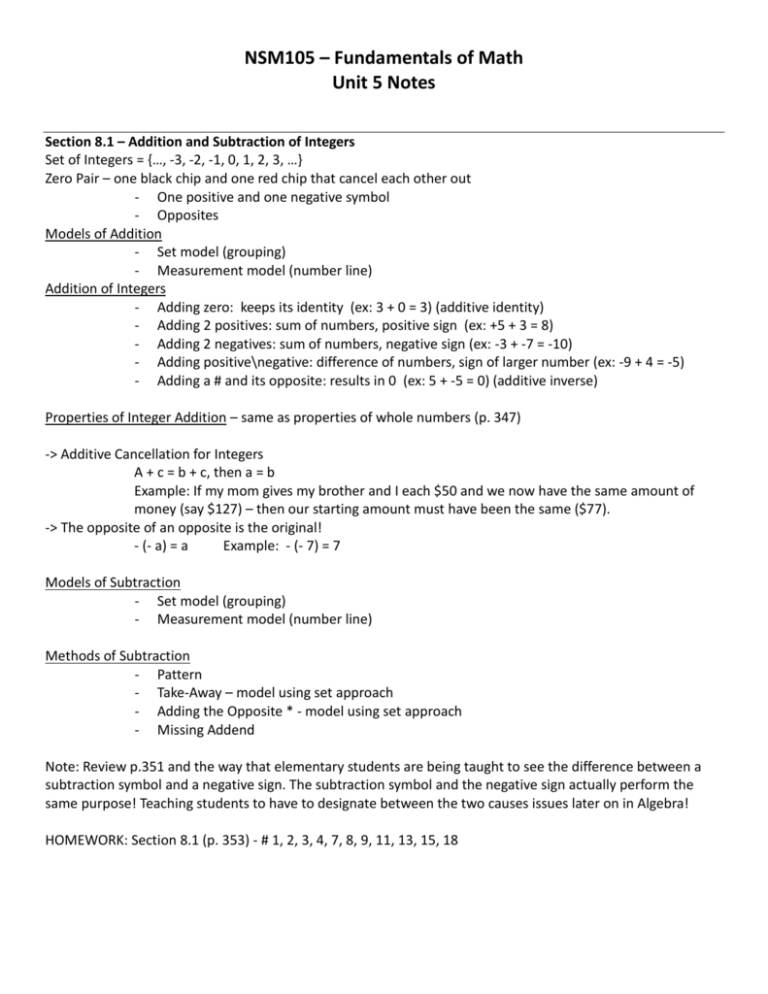
NSM105 – Fundamentals of Math
Unit 5 Notes
Section 8.1 – Addition and Subtraction of Integers
Set of Integers = {…, -3, -2, -1, 0, 1, 2, 3, …}
Zero Pair – one black chip and one red chip that cancel each other out
- One positive and one negative symbol
- Opposites
Models of Addition
- Set model (grouping)
- Measurement model (number line)
Addition of Integers
- Adding zero: keeps its identity (ex: 3 + 0 = 3) (additive identity)
- Adding 2 positives: sum of numbers, positive sign (ex: +5 + 3 = 8)
- Adding 2 negatives: sum of numbers, negative sign (ex: -3 + -7 = -10)
- Adding positive\negative: difference of numbers, sign of larger number (ex: -9 + 4 = -5)
- Adding a # and its opposite: results in 0 (ex: 5 + -5 = 0) (additive inverse)
Properties of Integer Addition – same as properties of whole numbers (p. 347)
-> Additive Cancellation for Integers
A + c = b + c, then a = b
Example: If my mom gives my brother and I each $50 and we now have the same amount of
money (say $127) – then our starting amount must have been the same ($77).
-> The opposite of an opposite is the original!
- (- a) = a
Example: - (- 7) = 7
Models of Subtraction
- Set model (grouping)
- Measurement model (number line)
Methods of Subtraction
- Pattern
- Take-Away – model using set approach
- Adding the Opposite * - model using set approach
- Missing Addend
Note: Review p.351 and the way that elementary students are being taught to see the difference between a
subtraction symbol and a negative sign. The subtraction symbol and the negative sign actually perform the
same purpose! Teaching students to have to designate between the two causes issues later on in Algebra!
HOMEWORK: Section 8.1 (p. 353) - # 1, 2, 3, 4, 7, 8, 9, 11, 13, 15, 18
NSM105 – Fundamentals of Math
Unit 5 Notes
Section 8.2 – Multiplication, Division, and Order
Models of Multiplication
- Set model (grouping)
- Measurement model (number line)
Multiplication of Integers
- Multiplying by zero: results in 0 (ex: 3 * 0 = 0)
- Multiplying by 1: keeps identity (ex: -8 *1 = -8) (multiplicative identity)
- Multiplying 2 positives: product of numbers, positive sign (ex: 5 * 3 = 15)
- Multiplying 2 negatives: product of numbers, positive sign (ex: -3 * -7 = 21)
- Multiplying positive\negative: product of numbers, negative sign (ex: -9 * 4 = -36)
Properties of Integer Multiplication – same as properties of whole numbers (p. 360)
Multiplying 2 Negatives…some real world examples:
1. Imagine that you buy five gift certificates worth $5 each and pay for them using your credit card.
You now owe money, so that's -$25.
The bill comes from the credit card company, but I take it away from you and insist on paying it.
You now have $25 worth of gift certificates without having paid anything.
Taking away a debt is analogous to negating a negative. Taking away five debts of $5 (-5*-5) equals
a gain of $25.
2. Imagine that you pay $750/month on your mortgage, that represents - $750 to your income. But
for a gift your mom offers to pay your mortgage for a year and “take away” that debt from you
(which represents another negative). Now we have -12 * -750, so you are up by $9000.
-> Any number * -1 becomes its opposite: Ex: 3(-1) = -3
Ex: (-5)(-1) = 5
-> Multiplicative Cancellation for Integers
Ac = bc, then a = b
-> Zero Divisors Property
If a and b are integers, then (a)(b)=0 IFF a=0 or b=0
Division of Integers
- Dividing by 1: keeps identity (ex: 14 ÷ 1 = 15)
- Dividing 2 positives: quotient of numbers, positive sign (ex: 15 ÷ 3 = 5)
- Dividing 2 negatives: quotient of numbers, positive sign (ex: 21 ÷ 3 = 7)
- Dividing positive\negative: quotient of numbers, negative sign (ex: 36 ÷ -4 = -9)
- Dividing 0 by a nonzero integer: results in zero (ex: 0 ÷ 12 = 0)
NSM105 – Fundamentals of Math
Unit 5 Notes
Ordering Integers Approaches
- Number-line approach – to the right is greater than
- Addition approach – a is less than b IFF there is positive integer p, such that a + p = b
Properties for Ordering Integers
- Transitive: if a < b and b < c, then a < c
- Less Than and Addition: if a < b and b < c, then a < c
- Less Than and Multiplication by a Positive: if a < b, then ap < bp
- Less Than and Multiplication by a Negative: if a < b, then an > bn
HOMEWORK: Section 8.2 (p.368) - # 3, 4, 7, 8, 12*, 20, 21, 28


